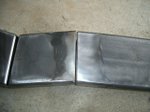In response to janeAnne's post about What would you do if money were no object to build a dream green home, I had to expand to a full post.
Here is what I originally responded with in the comments of her post:
If money were no object... but taste was:
- Active Solar water heating, and power generation.
- Passive solar heating and cooling.
- Xeriscaping.
- Intelligent house systems to reduce energy usage.
- Landscape design to reduce heating a cooling loads.
I know that there are more expensive technologies, but these could be incorporated into many current houses.
I followed up, answering questions with this comment:
janeAnne - I'm not a huge windmill in the neighborhood fan. I don't want to live under one, and I know that they will have a heavy NIMBY effect (Not In My BackYard).
On the other hand, active solar can be hidden in a house, no matter the style. I have heard of some roofing materials now that incorporate solar photo-voltaic cells and are almost indistinguishable from standard roofing.
Passive solar is an entire design philosophy, but things like sun-rooms and courtyards can be used to distribute air and light around the house. Overhangs can block heat during the summer, but allow solar heating in the winter.
Xeriscaping to save water... and make for a lower maintenance level... obvious choice. But, by using native plants, it can still be quite attractive. The overall landscaping can use little things like trees that block solar heat gain in the yard during the summer, but allow it during the winter. Blocking prevailing winds to allow the house to have a heat island is another option.
And, since I am a tool guy, what could be better than tools and technology turning things off and on, as well as optimizing everything to run more efficiently.
I had another response in the comments, but I'll refrain. So, without further ado, here is the expanded and explained list.
- Active Solar water heating and power generation
It should probably say active solar power generation and water heating, but... I didn't write that. However, in the summer, the greatest power use is on days with the most sun. So, having solar cells to create electricity to power A/C would just make sense. During the winter, the clear days are also usually the coldest, but instead of electric heat, why not use solar heat gain to heat water, and then circulate the water for radiant heat? The hot water could also be used to preheat the hot water for the house. A boiler running on natural gas could heat the water in place of or in addition to the solar heating.
- Passive solar heating and cooling
Unlike the first suggestion, this would require incorporation into the design of the home. Passive solar is a great way to heat a property in the winter in sunny areas. The basics are mass and glass. The sun shining into the area is used to heat mass. After the sun goes down, the mass continues to radiate the heat back into the house. Stone, brick, water and other materials with a lot of mass help to smooth the temperatures out. Think of a house with a two story greenhouse on the south side. In the greenhouse, the mass is situated to allow solar heating during the day. As the sun sets, additional insulating material covers the windows to reduce heat loss. The warmth from the sun-room is moved around the house.
During the summer, the light is blocked during the day, and the area is allowed to cool at night. The cool mass will help to lower the temperature in the house during the day. Appropriate overhangs can block the summer sun, but let the winter sun shine in as well.
- Xeriscaping
Simply put, this is landscaping to reduce additional water needs. Often through the use of native plants, less maintenance and water is used.
- Intelligent house systems to reduce energy usage
Most of us know that in a two story house, altering the HVAC vents from summer to winter will allow better distribution of air. Window treatments can be used as additional insulators. Operating heating, cooling and water heating systems only during times that they are being utilized also saves resources.
While none of these things are terribly difficult to accomplish, most of us don't fully utilize them because we don't think about it, or it isn't convenient. And, further efficiencies can be obtained from intelligent automation.
- Landscape design to reduce heating a cooling loads
This has nothing to do with xeriscaping. Through using deciduous tress (with leaves that drop during the winter) the summer sun can be partially blocked from heating the home and yard, but during the winter, the rays of the sun will heat the home and yard. Shrubs and evergreens can be used to block winter winds that cool part of the exterior of the house. In warmer climates, using the right vegetation can reduce the heat island effect of driveways and sidewalks.
None of these things are huge, and all are possible right now for reasonable cost. I know that I didn't have to work with a budget, but oddly, I think that the biggest part of the benefits are available with simpler technologies. The exotic technologies may produce additional savings, but I don't think they are cost efficient... and in some cases I don't think they are attractive or practical.









No comments:
Post a Comment